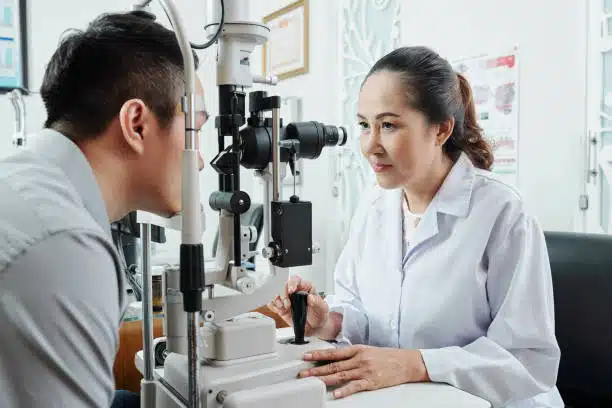Recognizing the Role of Your Eye Doctor in Keeping Vision
Recognizing the Role of Your Eye Doctor in Keeping Vision
Blog Article
Exploring the current Technical Developments in Optometry and What They Mean for Eye Doctors
From the accuracy of Optical Coherence Tomography to the nuanced understandings offered by AI-driven diagnostic devices, these developments are establishing new criteria in patient assessment and therapy. As these improvements penetrate the technique, optometrists are faced with the obstacle of accepting these tools to enhance patient outcomes.
Innovations in Diagnostic Devices
Progressing the area of optometry, advancements in diagnostic devices have transformed the way eye treatment experts examine and diagnose eye problems and aesthetic problems. The previous decade has actually seen substantial technical advancements, enabling more precise and extensive assessments. Optical Comprehensibility Tomography (OCT), for instance, provides high-resolution cross-sectional pictures of the retina, enabling the early discovery of diseases such as glaucoma and age-related macular deterioration. This non-invasive imaging method has become important in contemporary optometric technique.
One more trick advancement is the introduction of sophisticated corneal topography systems, which map the surface area curvature of the cornea with precision. These tools are specifically helpful for fitting get in touch with lenses and detecting corneal disorders. In addition, digital retinal imaging has actually changed standard ophthalmoscopy, offering comprehensive, breathtaking views of the retina that assist in comprehensive visual assessments.
The advancement of wavefront aberrometry has actually additionally been critical, allowing the analysis of refractive errors with unparalleled precision (Eye Doctor Optometrist). This innovation aids in tailoring rehabilitative lenses and improving medical end results for refractive surgical treatments. Jointly, these diagnostic improvements encourage eye doctors to deliver exceptional person care, making certain very early intervention and customized treatment techniques, inevitably boosting aesthetic health and wellness outcomes
AI in Individual Administration
Building on the structure of sophisticated analysis tools, the unification of fabricated intelligence (AI) in person monitoring stands for a transformative jump for optometry. AI systems are significantly utilized to enhance performance, precision, and personalization in person treatment. By evaluating large amounts of data, AI can recognize patterns and forecast potential eye problems, allowing optometrists to tailor interventions more efficiently. This ability is crucial in taking care of chronic eye diseases such as glaucoma and diabetic retinopathy, where very early discovery and continuous monitoring are key.
Furthermore, AI-driven systems facilitate streamlined person interactions and management processes. Automated scheduling, digital examinations, and personalized follow-up plans not only enhance patient satisfaction yet likewise maximize time management for experts. These systems can triage patients based on the necessity of their conditions, making certain that those in important need receive timely focus.
Additionally, AI improves decision-making by giving eye doctors with evidence-based referrals and treatment pathways. By integrating information from electronic health and wellness documents, AI devices supply insights that notify professional decisions, lowering the danger of mistakes and enhancing person outcomes. As AI remains to develop, its duty in patient administration will likely broaden, improving the landscape of optometric treatment.
Breakthroughs in Retinal Imaging
In the realm of optometry, retinal imaging has seen impressive technological developments that are improving diagnostic abilities and person treatment. Advancements such as Optical Comprehensibility Tomography (OCT) and fundus digital photography have transformed exactly how optometrists examine the retina and picture. OCT, in specific, offers high-resolution, cross-sectional pictures of the retina, permitting the in-depth examination of its layers. This ability is very useful for very early detection and management of conditions like glaucoma, diabetic person retinopathy, and age-related macular deterioration.
Improved imaging methods like OCT angiography are further refining analysis precision. Eye Doctor. Such innovations help with the identification of min retinal changes that could indicate condition progression.
Additionally, advancements in synthetic intelligence are enhancing retinal imaging by making it possible for automated evaluation of large datasets. These systems help eye doctors in recognizing patterns indicative of pathology, consequently enhancing diagnostic accuracy and effectiveness. Collectively, these advancements are changing retinal imaging right into a cornerstone of contemporary eye treatment, boosting outcomes and broadening healing possibilities.
Teleoptometry's Growing Function
Teleoptometry is progressively coming to be a vital component of eye care, driven by innovations in data and diagnostic devices. As optometry welcomes digital change, teleoptometry assists in remote appointments, allowing optometrists to extend their services past standard limits. This is specifically beneficial in country and underserved locations where access to specialized eye treatment is typically limited. By leveraging high-resolution video clip conferencing and advanced retinal imaging, eye doctors can carry out extensive eye exams from afar, guaranteeing timely diagnosis and therapy.
The combination of man-made intelligence (AI) more improves teleoptometry, allowing the analysis of visual information and aiding in the discovery of eye conditions such as glaucoma and diabetic person retinopathy. AI-powered algorithms can swiftly analyze complicated imaging information, supplying optometrists with important understandings that reinforce clinical decision-making.
Moreover, teleoptometry supports continuity of treatment through seamless integration with digital health documents (EHRs), permitting eye doctors to preserve thorough patient backgrounds. This ensures that individuals get customized and constant treatment also when consulting with different professionals.
In spite of these advantages, obstacles remain, consisting of making sure review data security and handling patient expectations. Nevertheless, teleoptometry represents a significant stride towards more obtainable, efficient, and patient-centered eye care. As technology evolves, its role is positioned to increase further.

Future Patterns in Eye Care
A myriad of innovative fads is established to improve the future of eye treatment, driven by technological improvements and the evolving demands of patients. One substantial trend is the assimilation of expert system (AI) in diagnostics, which guarantees to improve the accuracy and efficiency of eye examinations. AI formulas can analyze substantial amounts of data from retinal pictures, possibly spotting conditions like diabetic person retinopathy and glaucoma earlier than conventional methods.
In addition, personalized medication is obtaining grip in optometry, with genetic testing educating tailored treatment strategies. This approach intends to maximize individual outcomes by customizing treatments to individual hereditary profiles. Wearable technology, such as wise call lenses, is additionally on the horizon, using real-time monitoring of intraocular stress or sugar levels, thus supplying constant insights right into ocular and systemic health and wellness.
The adoption of augmented truth (AR) and virtual truth (VIRTUAL REALITY) in training and client education is one more arising trend. These technologies use immersive experiences that can enhance understanding and skills both for optometrists and people. As these trends advance, optometrists need to remain abreast of technical advancements to provide sophisticated treatment, guaranteeing better patient results and satisfaction in the vibrant landscape of eye treatment.
Conclusion

Collectively, these diagnostic innovations equip eye doctors to supply superior individual care, ensuring very early treatment and tailored therapy approaches, eventually improving aesthetic health end results.

As these technologies proceed to develop, eye doctors must adapt and our website integrate them right into method, inevitably optimizing process performance and boosting the requirement of eye care provided to people.
Report this page